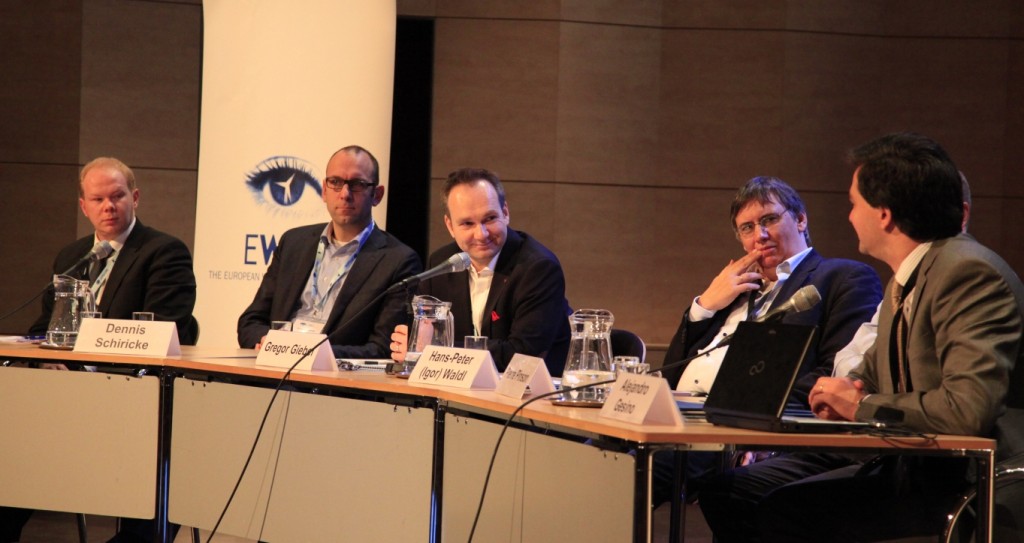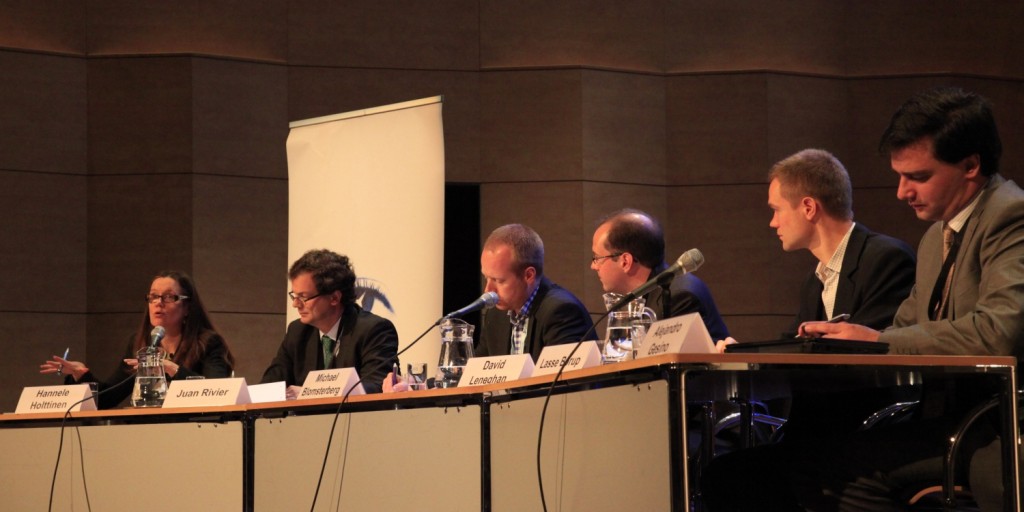Proceedings – Oral Presentations
The presentations are available for workshop participants and EWEA members to download below. The poster presentations are also available to download.
Session 1: The end users’ requirements
Chair: Lars Landberg, Senior Vice President; Innovation Manager, DNV GL – Energy (Garrad Hassan), Denmark
This session covered issues including:
- End-user requirements at different time-frames and for different applications
- What are the particular needs of TSOs, DSOs, utilities, energy traders, wind farm operators, aggregators, etc.?
- Seen from an end-user perspective what does the ideal system look like? What would be the one thing that would improve current systems?
- Value and perceived value of forecasts, e.g. what would the value of a 1% reduction in uncertainty be?
- Adoption of new forecasting tools in the lifecycle of business processes
- Observed mismatch between research in forecasting and the adoption of latest developments (e.g. ramp/uncertainty forecasting) into the business process of end-users.
- Standardisation: the need for standardised products, tools, data, evaluation protocols, etc. in order to supports communities sharing knowledge
| Managing the wind from a trader’s perspective (PDF) | Michael Blomsterberg, Head of Within Day Power, DONG Energy, Denmark |
| Reference architecture for wind power forecasting systems: ‘EweLine’ (PDF) | Wolfgang Slaby, Researcher – Energy Informatics, Fraunhofer IWES, Germany |
| Energy Forecasting Customers: analysing end users’ requirements (PDF) | Carlos Castaño, Head of R&D, GNARUM, Spain |
| Requirements of an energy company (PDF) | Tamar Nieuwenhuizen, Forecast Analyst, Eneco Energy Trade, The Netherlands |
Session 2: Numerical weather prediction models
Chair: Pierre Pinson, Professor, Centre for Electric Power and Energy, Technical University of Denmark (replaced Florian Pappenberger, Senior Scientist, European Centre for Medium-Range Weather Forecasts – ECMWF, UK, unable to attend owing to illness)
Numerical Weather Prediction (NWP) models provide information on the temporal and spatial evolution of wind speed and direction. NWP Forecasts are available on the short (less than two days) and medium range (up to 15 days) and are a significant driver of wind energy forecasts.
The methods and models on which these forecasts are based are evolving continuously and skill of wind forecasts are persistently improving. In particular, the representation of uncertainty has improved with the ever increasing popularity and skill of ensemble forecasts. In addition methods for downscaling by using limited area models or post-processing routines have been refined.
This session included contributions from NWP developers presenting the current state-of-the-art and future developments with respect to wind forecasting. A particular focus was the development of ensemble systems. The session aimed to foster the dialogue between the wind forecasting community and NWP model developers by asking for contributions from NWP users evaluating the properties, skills, strengths and weaknesses of NWP models.
| The benefits and developments in ensemble wind forecasting (PDF) | Erik Anderson, Deputy Director, Forecast Department, European Centre for Medium-Range Weather Forecasts – ECMWF, UK |
| Improvement of wind forecasts through limited area modelling (PDF) | Clive Wilson, Mesoscale Model Development and Diagnostics Manager, MetOffice, UK |
| Increased wind power forecast skill due to improved NWP in the last decade (PDF) | Lueder von Bremen, Team Leader, ForWind, University of Oldenburg, Germany |
| Assimilation of wind power data to improve the numerical weather prediction system and the wind power prediction (PDF) | Stefan Declair, Scientific Researcher, Deutscher Wetterdienst (DWD), Germany |
Session 3: Wind power forecasting models and operational systems
Chair: George Kariniotakis, Head of Renewable Energies & Smartgrids Group, Centre PERSEE, MINES ParisTech/ARMINES, France
Despite the maturity of “usual forecasting” there is a continuous need to improve the accuracy of wind power predictions at different spatial and temporal scales and especially for “extreme” situations where prediction errors have a high impact for end-users. In parallel as wind penetration increases it becomes more and more necessary to have reliable uncertainly estimations through probabilistic forecasting approaches.
This session addressed these challenges by presenting advances that of high interest for both the research and industry communities. First, the results of the benchmark exercise organised in the frame of the COST Action WIRE were presented. This included comparisons of probabilistic predictions for wind and photovoltaic power and gave an idea where the technology is today and what progress has been achieved in terms of accuracy in the last years. Next, progress on predicting extreme situations, with focus on the case of turbine icing, was presented. Advances on the field of probabilistic forecasting for the case of single wind farms and aggregates were also presented. Finally, the session concluded with an advanced approach for generating realistic scenarios for wind power forecasts and realised production. Such scenarios are required for wind integration studies, which are of strategic importance for further deployment of renewables.
These presentations, together with the presentations in the poster session, were the starting point for a discussion at the end of the session on the progress the future challenges and the research priorities for the wind power forecasting technology.
| Presentation of the results of the WIRE exercise (PDF) | Stefano Alessandrini, Researcher, RSE Spa, Italy |
| Enhanced Wind Power Forecasts using New Methods for Predicting Turbine Icing (PDF) | Lars Landberg, Senior Vice President; Innovation Manager, DNV GL – Energy (Garrad Hassan), Denmark |
| Spatially aggregated probabilistic wind power forecasts using weather forecasting ensembles (PDF) | John Bjørnar Bremnes, Research scientist, Norwegian Meteorological Institute, Norway |
| A Unified Method for Probabilistic Forecasts of Wind Power Generation (PDF) | Jan Kloppenborg Møller, Assistant Professor DTU-Compute Technical University of Denmark |
| The Wind Integration National Dataset (WIND) Toolkit: wind power forecasts and production time series (PDF) | Caroline Draxl, Senior Scientist, National Wind Technology Center, National Renewable Energy Laboratory – NREL, USA |
Wednesday 4 December 2013
Session 4: Integrating forecasts in business processes
Chair: Gregor Giebel, Senior Scientist, DTU Wind Energy, Denmark
Wind power forecasts have been used for many years to increase the information available for the end user. While the forecasts were able to provide more information especially about the uncertainty bands, the most commonly used forecast was just the central deterministic one, since no decision making processes were developed on the background of the full forecast products. However, in recent years the users’ business processes were remodelled to take the forecast input into account. In this session examples of the coupling of forecasting output to specific business processes were shown.
Oral presentations gave examples of the diverse range of topics where wind (power) forecasting is used, from forecasting the wind and weather windows during construction, to the use and role in trading, and the implementation of the ANEMOS tool for many different use cases.
Posters presented further topics on the integration of forecasting into specific business processes such as trading, buying and selling wind farms, power system operation, and the proper integration with actual working wind farms.
| RES forecasting from a TSO perspective (PDF) | Alejandro Gesino, Customers & Markets, Market Design Renewable Energy, Tennet TSO GmbH, Germany |
| Development of new planning tools for coping with volatile weather conditions in the offshore wind energy supply chain (PDF) | Michael Görges, Project Manager R&D, BLG Logistics Solutions GmbH & Co. KG, Germany |
| The role and value of wind power forecasts in electricity markets (PDF) | Pierre Pinson, Professor, Centre for Electric Power and Energy, Technical University of Denmark |
| Wind Power Forecast system & Wind power trading concept (PDF) | Dennis Schiricke, OutSmart B.V., The Netherlands |
| Prediction solutions made to measure based on the flexible Anemos forecasting platform (PDF) | Hans-Peter (Igor) Waldl, Managing Director, Overspeed GmbH & Co. KG, Germany |
Session 5: Panel discussion: how important will forecasting be at 200GW?
Chair: Hannele Holttinen, Principal Scientist, Technical Research Centre of Finland – VTT, Finland
The closing panel discussion covered topics including:
- How do the end user requirements change when wind power reaches 200 GW?
- What are the requirements for accuracy?
- What are the requirements for new applications and ways of using forecasts in control rooms?
Discussion points included:
- Producers: participation in electricity markets, ancillary services, bidding tools;
- Increased collaboration with TSO/DSO as well as PV/wind combined;
- Offshore forecasts.
Panellists:
|
NB: No presentations were given during the panel discussion.
Organising committee:
- George Kariniotakis, Head of Renewable Energies & Smartgrids Group, Centre PERSEE, MINES ParisTech/ARMINES, France
- Lars Landberg, Senior Vice President; Innovation Manager, DNV GL – Energy (Garrad Hassan), Denmark
- Tim Robinson, Conference Programme Team Leader, EWEA – The European Wind Energy Association asbl/vzw







Follow EWEA on: